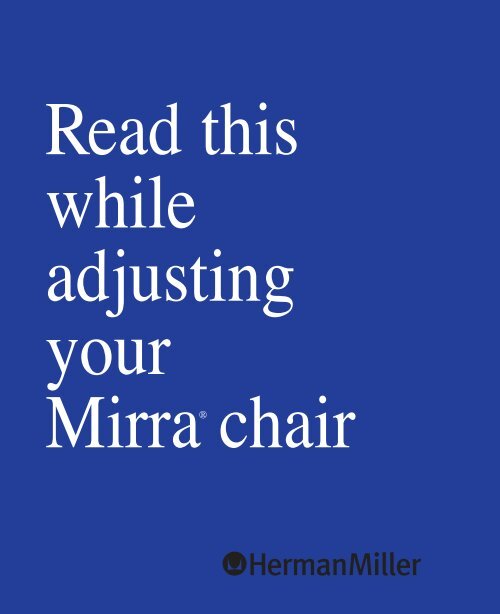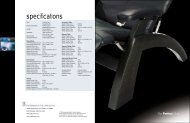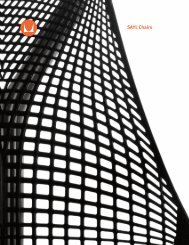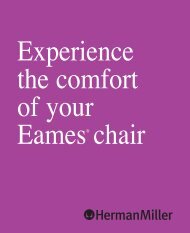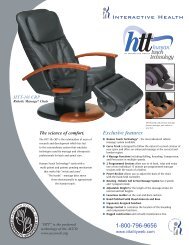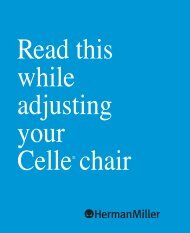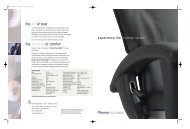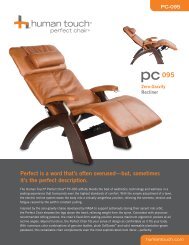Adjustments - Herman Miller
Adjustments - Herman Miller
Adjustments - Herman Miller
Create successful ePaper yourself
Turn your PDF publications into a flip-book with our unique Google optimized e-Paper software.
Read this<br />
while<br />
adjusting<br />
your<br />
Mirra®<br />
chair
Instructions on this card show all<br />
possible adjustments. Specific adjustments<br />
vary according to chair model.<br />
To view the Mirra chair user-adjustment video,<br />
visit www.<strong>Herman</strong><strong>Miller</strong>.com
Seat Height<br />
Tab next to tilt tension knob, lower right<br />
Harmonic Tilt Tension<br />
Knob below right front side of seat<br />
To raise: While taking your weight off chair,<br />
lift tab up.<br />
To lower: While seated, lift tab up.<br />
To increase: Turn knob clockwise.<br />
To decrease: Turn knob counterclockwise.<br />
Adjust chair height so your feet rest flat on floor or<br />
footrest, with your body comfortably supported by<br />
breathable AireWeave suspension. Avoid dangling<br />
legs, which puts pressure on the back of thighs and<br />
restricts blood flow. A work surface or keyboard<br />
that seems too high or low may require adjusting.<br />
Increased tilt tension provides more stability and<br />
back support while you recline.
FlexFront ® Seat Depth<br />
Handle under front of seat<br />
Arm Height<br />
Tab on outside lower base of each arm<br />
Squeeze handle and adjust seat edge up or<br />
down. Release handle to lock in position.<br />
To raise or lower arms: Raise tab to unlock<br />
arm, adjust arm, lower tab to lock.<br />
For maximum back support, adjust chair depth<br />
(distance from hip to knee) so the seat edge<br />
doesn’t hit the back of your legs.<br />
Adjust height of each chair arm so your<br />
arms are supported. This helps take weight<br />
off your shoulders.
Arm Angle<br />
Front of each armpad<br />
Arm Width<br />
Button on inside of each armpad<br />
To pivot arms in or out: Grasp front end of<br />
armpad and pivot it to the left or right.<br />
To adjust: Engage button and adjust arm in<br />
or out.<br />
Adjusting arm angle can help support different<br />
types of work and shifts in posture. For example,<br />
adjust chair arms inward for support while<br />
using keyboard; adjust arm out for support<br />
when using mouse.<br />
Adjust width of each chair arm so your<br />
arms are supported. This helps take weight<br />
off your shoulders.
Forward Tilt<br />
Horizontal tab on left front side of seat<br />
Tilt Limiter<br />
Vertical tab on left front side of seat<br />
To position chair forward: Recline and<br />
flip lever down.<br />
To resume horizontal position: Recline and<br />
flip lever up.<br />
To engage: Recline and move lever up to<br />
define the limit of recline.<br />
To release: Lean forward and press lever back.<br />
Forward tilt with a 4-degree range provides full<br />
support while leaning forward for task-intensive<br />
work, such as keyboarding. Normally, forward<br />
tilt position is used with increased chair height.<br />
This position helps the body achieve a more<br />
neutral, open angle between trunk and thighs.<br />
If you want to sit in an upright position, set<br />
the tilt limiter when the seat is in a horizontal<br />
or forward position.
Lumbar Height<br />
Levers on lumbar support<br />
Lumbar Depth<br />
Levers on lumbar support<br />
To raise or lower: Move levers up to<br />
loosen, slide lumbar support up or down<br />
to desired height.<br />
To increase lumbar support: Adjust levers<br />
downward.<br />
To decrease lumbar support: Raise levers<br />
upward.<br />
Although the chair back automatically adjusts<br />
to your size and posture, you can fine-tune<br />
lumbar support by adjusting the bar so that it<br />
comfortably supports the natural curve of your<br />
spine. Once support is adjusted, it follows<br />
you throughout your range of recline.
User<br />
information:<br />
Installers<br />
do not remove<br />
Users: Retain This Information for Future Reference<br />
Maintenance<br />
A periodic inspection of chair components and fasteners should be made to ensure that<br />
the chair is structurally intact and functioning properly. Damaged and broken parts should<br />
be replaced and loose fasteners tightened.<br />
For more information about our products and services or to see a list of dealers, please<br />
visit us at www.<strong>Herman</strong><strong>Miller</strong>.com or call (800) 851 1196.<br />
© 2005 <strong>Herman</strong> <strong>Miller</strong>, Inc., Zeeland, Michigan Printed in U.S.A. Part No. 1B10JJ-C O.MR6200<br />
® yz, FlexFront, and Mirra are among the registered trademarks of <strong>Herman</strong> <strong>Miller</strong>, Inc.<br />
AireWeave and Harmonic are among the trademarks of <strong>Herman</strong> <strong>Miller</strong>, Inc.


